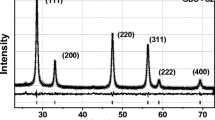Abstract
Electrical properties of 10 mol% Gd2O3–90 mol% CeO2 (GDC10) and 20 mol% Gd2O3–80 mol% CeO2 (GDC20) ceramics, sintered in various temperatures from 1100 to 1500 °C for 2 h, have been investigated by 2- and 4-electrode impedance measurement methods. The sintering temperature was found to have a significant effect on electrical properties of the grain boundary medium. A brick-layer model-based analysis of the experimental data of grain boundary medium was carried out for the estimation of proportion ratio between grain dimension and grain boundary thickness. Impedance spectra, obtained by 4-electrode method, were also examined by numerically calculating the probability density function of distribution of relaxation times of charge carriers. The latter method revealed time domain behavior of the system, which allowed more accurate evaluation of the most probable relaxation times. GDC10 samples, sintered at 1400 and 1500 °C, showed a particular relaxation behavior of charge carriers in grain boundary medium. Two distinct peaks of the imaginary impedance (both associated to grain boundary) were detected, which suggest that grain boundary medium in these specimens may consist of two phases with different electrical properties.







Similar content being viewed by others
References
Fergus JW (2010) Electrolytes for solid oxide fuel cells. J Power Sources 162:30–40
Steele BCH (2000) Appraisal of Ce1−yGdyO2−y/2 electrolytes for IT-SOFC operation at 500°C. Solid State Ion 129:95–110
Hui S, Roller J, Yick S, Zhang X, Decès-Petit C, Xie Y et al (2007) A brief review of the ionic conductivity enhancement for selected oxide electrolytes. J Power Sources 172:493–502
Kuharuangrong S (2007) Ionic conductivity of Sm, Gd, Dy and Er-doped ceria. J Power Sources 171:506–510
Mogensen M, Sammes NM, Tompsett GM (2000) Physical, chemical and electrochemical properties of pure and doped ceria. Solid State Ion 129:63–94
Kežionis A, Šalkus T, Petraitis A, Dudonis J, Laukaitis G, Milčius D et al (2009) Peculiarities of ionic transport of oxygen vacancy conducting superionic ceramics. Lithuanian J Phys 49:317–322
Zha S, Xia C, Meng G (2003) Effect of Gd(Sm) doping on properties of ceria electrolyte for solid oxide fuel cells. J Power Sources 115:44–48
Lee KR, Lee JH, Yoo HI (2014) Grain size effect on the electrical properties of nanocrystalline ceria. J Eur Ceram Soc 34:2363–2370
Reddy K, Karan K (2005) Sinterability Mechanical, Microstructural, and Electrical Properties of Gadolinium-Doped Ceria Electrolyte for Low-Temperature Solid Oxide Fuel Cells. J Electroceram 15:45–56
Öksüzömer MAF, Dönmez G, Sariboğa V, Altinçekiç TG (2013) Microstructure and ionic conductivity properties of gadolinia doped ceria (GdxCe1−xO2−x/2) electrolytes for intermediate temperature SOFCs prepared by the polyol method. Ceram International 39:7305–7315
Jadhav LD, Pawar SH, Chourashiya MG (2007) Effect of sintering temperature on structural and electrical properties of gadolinium doped ceria (Ce0.9Gd0.1O1.95). Bull Mater Sci 30:97–100
Lenka KR, Mahata T, Tyagi AK, Sinha PK (2010) Influence of grain size on the bulk and grain boundary ion conduction behavior in gadolinia-doped ceria. Solid State Ion 181:262–267
Arabacı A, Öksüzömer MF (2012) Preparation and characterization of 10 mol% Gd doped CeO2 (GDC) electrolyte for SOFC applications. Ceram International 38:6509–6515
Kazlauskas S, Kežionis A, Šalkus T, Orliukas AF (2013) Electrical properties of YSZ and CaSZ single crystals. Solid State Ion 231:37–42
Kazlauskas S, Kežionis A, Šalkus T, Orliukas AF (2014) Charge carrier relaxation in solid VO•• conductors. Solid State Ion 262:593–596
Kazlauskas S, Kežionis A, Kazakevičius E, Orliukas AF (2014) Charge carrier relaxation and phase transition in scandium stabilized zirconia ceramics. Electrochim Acta 134:176–181
Huang K, Feng M, Goodenough JB (1998) Synthesis and Electrical Properties of Dense Ce0.9Gd0.1O1.95 Ceramics. J Am Ceram Soc 81:357–362
Chiodelli G, Malavasi L, Massarotti V, Mustarelli P, Quartarone E (2005) Synthesis and characterization of Ce0.8Gd0.2O2−y polycrystalline and thin film materials. Solid State Ion 176:1505–1512
Kežionis A, Butvilas P, Šalkus T, Kazlauskas S, Petrulionis D, Žukauskas T et al (2013) Four-electrode impedance spectrometer for investigation of solid ion conductors. Rev Sci Instrum 84:013902
Kežionis A, Kazakevičius E, Šalkus T, Orliukas AF (2011) Broadband high frequency impedance spectrometer with working temperatures up to 1200 K. Solid State Ion 188:110–113
Tikhonov AN (1963) Regularization of ill-posed problems. DAN SSSR 153:49–52
Badwal SPS (1984) Electrical conductivity of single crystal and polycrystalline yttria-stabilized zirconia. J Mater Sci 19:1767–1776
Ngai KL (1998) Evidence of interaction between oxygen ions from conductivity relaxation and quasielastic light scattering data of yttria-stabilized zirconia. Philosophical Mag Part B 77:187–195
Liu AZ, Wang JX, He CR, Miao H, Zhang Y, Wang WG (2013) Synthesis and characterization of Gd0.1Ce0.9O1.95 nanopowder via an acetic–acrylicmethod. Ceram International 39:6229–6235
Maca K, Cihlar J, Castkova K, Zmeskal O, Hadraba H (2007) Sintering of gadolinia-doped ceria prepared by mechanochemical synthesis. J Eur Ceram Soc 27:4345–4348
Jud E, Gauckler L (2005) The Effect of Cobalt Oxide Addition on the Conductivity of Ce0.9Gd0.1O1.95. J Electroceram 15:159–166
Hsieh TH, Ray DT, Fu YP (2013) Co-precipitation synthesis and AC conductivity behavior of gadolinium-doped ceria. Ceram International 39:7967–7973
Van Dijk T, Burggraaf AJ (1981) Grain boundary effects on ionic conductivity in ceramic GdxZr1–xO2–(x/2) solid solutions. Phys Status Solidi (a) 63:229–240
Acknowledgements
This research was funded by a Grant No. ATE-09/2012 from the Research Council of Lithuania.
Author information
Authors and Affiliations
Corresponding author
Rights and permissions
About this article
Cite this article
Kazlauskas, S., Kežionis, A., Šalkus, T. et al. Effect of sintering temperature on electrical properties of gadolinium-doped ceria ceramics. J Mater Sci 50, 3246–3251 (2015). https://doi.org/10.1007/s10853-015-8892-5
Received:
Accepted:
Published:
Issue Date:
DOI: https://doi.org/10.1007/s10853-015-8892-5




